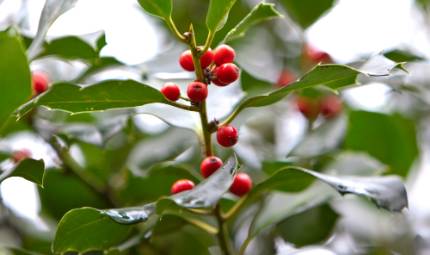Wildlife Garden holly. The red holly berries are easy to spot in winter and they're only on the female trees. Although toxic to humans, they are an important food source for birds, lasting longer than many other fruits even after frost.
Children's wishes for a white Christmas this year may be sadly unanswered, but the mild weather does mean that on your winter walks you might actually spot some unusual things. And you can also help us in our Great holly hunt by telling us what holly you find locally and where on our online urban tree survey map.
Last week, which was decidedly colder around parts of the country, the Museum's film unit went to record Museum wildlife expert Fred Rumsey on a very wintry walk through the woods near our Tring Museum in Hertfordshire.
Watch our lovely festive video and find out what you could discover on a winter walk near you and who the mystery nibbler is...
Although many birds migrate over the winter there are still lots of garden birds out and about, including cheeky robins. In the Museum's Wildlife Garden in South Kensington, Caroline Ware, the garden's manager tells me:
'There are 7 moorhens pottering around and feeding in the Wildlife Garden which is very unusual for this time of the year and bluebell leaves are already appearing in the some of the woodland areas. We've had lots of bird species visiting the bird feeder including bluetits, great tits, coal tits and greenfinches, as well as robins. On the ground there are feeding dunnocks, and squirrels and mice are rushing around, and even invading our garden shed.'
Territorial Strut by Ross Hodinutt. This award-winning image in the Veolia Environnement Wildlife Photographer of the Year 2011 exhibition captures the robin's renowned perkiness beautifully. Ross snapped it in his Devon garden in the unusually cold spell last December.
On our Wildlife in winter page you'll find ideas for seasonal surveys to take part in, species to spot, and wildlife watching tips.
Read the Great holly hunt news story to find out some fascinting facts about this festive shrub, there's even a tea you can make from it...
Browse our Festive Season pages for suggested seasonal activites at the Museum if you're visiting. The Ice Rink and Veolia Environnements Wildlife Photographer of the Year exhibition are not to be missed.
Holly trees (Ilex species). The most well-known species in Britain is the common or European holly, Ilex aquifolium, one of only three native European species.
Robins (Erithacus rubecula) are one of the few birds to sing all year round. They do so to defend their territory and attract a mate. Their spring song - more powerful and upbeat than their melancholy autumn song - begins from mid-December.
Happy Christmas and New Year to you all.




